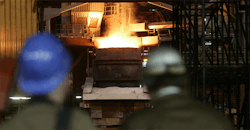U.S. Manufacturing Growth Cooled in July From One-Year High
U.S. manufacturing expanded in July, though at a slower pace, indicating gradual improvement that could help the economy emerge from a weak first half of the year.
The Institute for Supply Management’s index cooled to 52.6 from a one-year high of 53.2 a month earlier, the Tempe, Arizona-based group’s report showed Monday. Readings above 50 indicate growth. The median forecast in a Bloomberg survey of economists was 53.
Factories cut back on employment even as orders and production remained strong last month, indicating producers are focused on cost-cutting as the economy struggles to gain speed. Stronger consumer spending is helping to limit the impact of weaker global demand and reductions in corporate investment.
“Over the near term, I think it’s just going to be plodding along, slow growth” in manufacturing, said Josh Shapiro, chief U.S. economist at Maria Fiorini Ramirez Inc. in New York. “It’s not like we’ve been getting wonderful economic news from around the world.”
Estimates for the manufacturing index in the Bloomberg survey ranged from 51.1 to 54. Eleven of 18 industries reported growth in July, including textiles, wood products, chemical products and furniture.
The ISM’s gauge of new orders was little changed at 56.9 last month after 57 in June. A measure of production picked up to 55.4 from 54.7. The employment index decreased to 49.4 in July from 50.4 a month earlier, contracting for the seventh time in the past eight months.
Factory Employment
The report also showed factory inventories shrank in July, while prices climbed at a slower pace.
“We’re pretty much where we were last month, and we’re on a pretty positive trend over the last five to seven months,” Bradley Holcomb, chairman of the ISM’s factory survey, said on a conference call with reporters.
Overseas economies have been treading water, limiting demand for American merchandise. While a government measure of manufacturing in China contracted, private gauges showed growth in July.
Euro-area manufacturing slowed in July as uncertainty following Britain’s vote to leave the European Union damped orders, according to Markit Economics.
A jobs report due Friday from the U.S. Labor Department is projected to show payrolls rose 180,000, in line with the 172,000 monthly average so far in 2016, according to the median estimate in a Bloomberg survey.
Federal Reserve policy makers said last week that the U.S. benchmark interest rate would remain unchanged at least until their next meeting in September. The officials are still in a wait-and-see mode as they look for further progress on inflation, employment and global-growth prospects.
The Fed meeting took place ahead of the Commerce Department’s report Friday that showed gross domestic product rose at a 1.2 percent annualized rate after a 0.8 percent advance the prior quarter.
- Michelle Jamrisko, Bloomberg News
